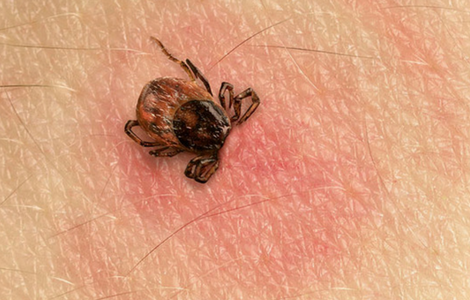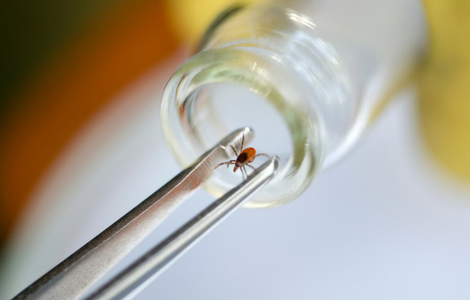Lyme Disease
Lyme disease is on the rise across Canada. It is a serious illness that is spread by the bite of infected blacklegged ticks.
Tick populations are rapidly growing and spreading across many regions in Canadian provinces, including Ontario, Manitoba, Quebec, New Brunswick, Nova Scotia, and British Columbia. Lyme disease is caused by a type of bacteria called Borrelia burgdorferi. Infected Blacklegged ticks can spread Lyme disease to humans through their bite. Ticks become infected with Lyme disease by feeding on infected wild animals such as deer, birds, and small rodents.
Ticks are an opportunistic pest. For you or your pet to contract Lyme disease, you would need to have been bitten by an infected blacklegged tick. For this to happen, a tick would have attached itself to you
or your pet. Ticks don’t jump or fly; instead, they rest on low growing grasses or plants and wait for a host (human or animal) to pass by. When you or your pet brush past the plant, the tick will cling to clothing or fur, before crawling around looking for a place to attach itself and start feeding. Once the tick has bitten, bacteria enter the skin and eventually makes its way into the bloodstream. If the tick
looks swollen, it may have been feeding for a long enough time to transmit bacteria, which is why it’s so important to take the correct precautions if you or your pet have been in tick-prone areas.
In most cases, it takes around 36 to 48 hours of attachment for Lyme disease to be transmitted, so if you discover an attached tick, it’s important to carefully extract it as soon as possible.
Removing ticks
- Using clean tweezers, carefully grasp the tick as close to the skin as possible. Pull slowly upward, but try not to twist or crush the tick.
- Once the tick is removed, wash the area where you were bitten with soap and water. You may also disinfect the area with alcohol or hand sanitizer. Wash your hands with soap and water.
- If parts of the tick’s mouth break off and remain in your skin, remove them with tweezers.
Visit your health care provider if you cannot remove:
- parts of the tick’s mouth in your skin
- the tick itself because it has buried itself deep into your skin

Saving Ticks
If you can’t submit the tick for testing right away, then:
- Save the tick in a plastic bag that you can seal or a pill bottle. Record the location and date of the bite.
- Store the container for up to 10 days in the refrigerator for live ticks or freezer, for dead ticks
Lyme disease can have serious effects on people and pets and the symptoms can differ from person to person. Signs and symptoms of Lyme Disease can include one or a combination of the following with varying degrees of severity:
- Skin Rash
- Dizziness
- Headache
- Abnormal heartbeat
- Fever or chills
- Muscle and joint pain
- Fatigue (tiredness)
- Paralysis Spasms or weakness
- Mental confusion
- Numbness or tingling
- Nervous system disorders
- Swollen lymph nodes

See our Services in Action
Postal Code or Zip Code Not Found
Please select your city from the list below
- Airdrie
- Aldersyde
- Balzac
- Bearspaw
- Beiseker
- Black Diamond
- Bragg Creek
- Calgary
- Cheadle
- Chestermere
- Cochrane
- Conrich
- Crossfield
- Dalmead
- Dalroy
- Delacour
- Dewinton
- Elbow Valley
- Foothills
- Greater Calgary
- Heritage Pointe
- High River
- Indus
- Irricana
- Janet
- Kathryn
- Keoma
- Langdon
- Lyalta
- Madden
- Millarville
- Mountainview
- Okotoks
- Oothills
- Prarie Royal
- Priddis
- Prince Of Peace
- Redwood Meadows
- Rockyview
- Shepard
- Springbank
- Strathmore
- Symons Valley
- Turner Valley
- Wheatland
- Abbotsford
- Aldergrove
- Brentwood Bay
- Burnaby
- Chemainus
- Chilliwack
- Cobble-Hill
- Comox
- Coquitlam
- Cordova Bay
- Courtenay
- Delta
- Kamloops
- Kelowna
- Ladysmith
- Lake Country
- Langley
- Lantzville
- Maple Ridge
- Mill Bay
- Mission
- Nanaimo
- New Westminster
- North Saanich
- North Vancouver
- Parksville
- Peachland
- Penticton
- Pitt Meadows
- Port Coquitlam
- Port Moody
- Qualicum Beach
- Richmond
- Salmon Arm
- Shawnigan Lake
- Sidney
- South Island
- Summerland
- Surrey
- Vancouver
- Vancouver Area
- Vernon
- Victoria
- West Kelowna-Westside
- West Vancouver
- White Rock
- Ajax
- Alliston
- Almonte
- Ancaster
- Angus
- Aurora
- Ayr
- Bala
- Barrie
- Belleville
- Blackstock
- Bolton
- Bowmanville
- Bracebridge
- Bradford
- Brampton
- Brantford
- Brockville
- Brooklin
- Burlington
- Cambridge
- Capreol
- Carleton Place
- Carp
- Casselman
- Chelmsford
- Chesterville
- Clarence Creek
- Collingwood
- Concord
- Cookstown
- Copper Cliff
- Courtice
- Durham Region East
- Durham Region West
- Elmira
- Embrun
- Erin
- Etobicoke
- Fort Erie
- Gananoque
- Gloucester
- Gormley
- Gravenhurst
- Greater Sudbury
- Grimsby
- Guelph
- Hamilton
- Hanmer
- Holland Landing
- Innisfil
- Kanata
- Kemptville
- Keswick
- King City
- Kingston
- Kitchener
- Lively
- London
- Manotick
- Maple
- Markham
- Metcalfe
- Milton
- Mississauga
- Mount Albert
- Muskoka
- Napanee
- Nepean
- New Hamburg
- Newmarket
- Newtonville
- Niagara
- Niagara Falls
- Niagara-on-the-Lake
- Oakridges
- Oakville
- Orillia
- Orleans
- Orono
- Oshawa
- Ottawa
- Pickering
- Port Carling
- Port Colborne
- Port Perry
- Richmond
- Richmond Hill
- Rockcliffe - Manor Park
- Rockwood
- Rosseau
- Russell
- Sault Ste. Marie
- Scarborough
- Schomberg
- St. Catharines
- St. Thomas
- Stittsville
- Stouffville
- Stratford
- Sudbury
- Thornhill
- Thorold
- Tillsonburg
- Toronto
- Unionville
- Uxbridge
- Val Caron
- Vanier
- Vaughan
- Wasaga Beach
- Waterloo
- Welland
- Whitby
- Whitchurch-Stouffville
- Woodbridge
- Woodbridge/Maple
- Woodstock
- York North
- York South
